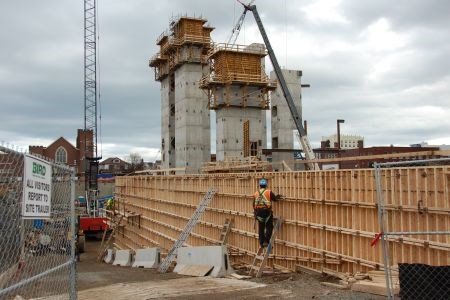Driving down the Thunder Bay Expressway not long ago, Harold Lindstrom took note of an unusual, but encouraging, sight.
“It's the first time I've seen the Bowater plant with all its stacks going, and chip piles are as high as they've ever been,” said the manager of the Construction Association of Thunder Bay. It might be a sign of more good things to come.
For decades, local labour was geared to industrial expansion and upgrades at the area's pulp and paper and lumber industry. For the better part of the last 10 years, it's been a constant wave of mill closures and job losses.
“Our forestry industry has died,” said Lindstrom. “It's been a slow death over a few years.”
However, the association's contractors and fabricators learned to change gears and found project work in Western Canada, as well as closer to home with mineral development and mine expansion in northwestern Ontario.
“Red Lake is an unbelievable story,” along with ongoing work and expansion at Marathon, Musselwhite, Hemlo and North American Palladium's Lac des Iles mine north of the city, said Lindstrom.
“It's all starting with people servicing exploration companies here.”
Lindstrom said mine-related infrastructure work has already replaced what was lost in forestry.
With Cliffs Natural Resources setting up an office in Thunder Bay, he's hopeful one of the spinoffs of the Ring of Fire chromite deposit in the Far North could be a ferrochrome furnace plant in the community.
Institutional construction has dominated the regional construction scene with a new $65-million hospital in Sioux Lookout and numerous building projects in First Nation communities.
In Thunder Bay, a new $11-million Emergency Medical Services building is going up in the city's north end and at the bottom of Red River Road, the first of three phases of a $122-million waterfront revitalization project has been completed.
In the city's south downtown core, the foundation work and elevator shafts on a $247-million new consolidated courthouse were being erected this fall.
Bird Design-Build Construction is the general contractor and the many local companies will benefit over its three-year construction life.
Close by, a new $13.5-million District of Thunder Bay Social Services Administration Board building is expected to be finished in early 2012.
Lindstrom said aside from new condominium, seniors home and retail construction, between 80 per cent and 90 per cent of activity in town is for government-funded projects.
Political money for roads and expressways has flowed into Thunder Bay, including construction of the city's first cloverleaf on Highway 11-17 at Hodder Avenue and Copenhagen Road. Four-laning the Trans-Canada Highway to Nipigon continues with a series of bridges over the Mackenzie River.
The city has resurfaced more than 15 kilometres of streets this year with nine kilometres of bike lanes added.
On the home-building scene, warm weather in October extended activity well into the fall.
Canada Mortgage and Housing Corporation (CMHC) recorded 22 single-detached starts in October, three ahead of the 10-year average for that month.
In single-family house construction, CMHC recorded 164 starts for this year, until the end of October, down from 181 posted during the same period last year.
Warren Philp, CMHC's Northern Ontario market analyst, forecasted 190 starts to finish the year, down from 204 recorded last year.
Surprisingly the number of multi-residential starts in Thunder Bay was up almost 80 per cent. Most of it was apartment and condo construction with 184 units recorded in 2011, way up from 14 last year.
Philp attributes most of that to an affordable housing project run by the St. Joseph's Care Group.
On the residential resale market, Philp said the big picture in Thunder Bay is that the low number of home listings remains an issue.
The shortage of listings will lead to a 7.1 per cent price increase this year, with another six per cent forecasted for 2012.
Due to bidding wars, Philp said it was a “phenomenal number” of units selling over list price, even while the number of sales declined nine per cent.
“It's a bit of a dichotomy,” said Philp. “There's still reasonable demand and when you factor in a weak number of listings, when there is a listing that looks decent, it's often snapped up.”
Why so few listings?
Philp theorizes because of the city's aging population, many are choosing to stay in their homes.
What might change to free up more listings is if price increases continue, people may decide it's a good time to sell.




